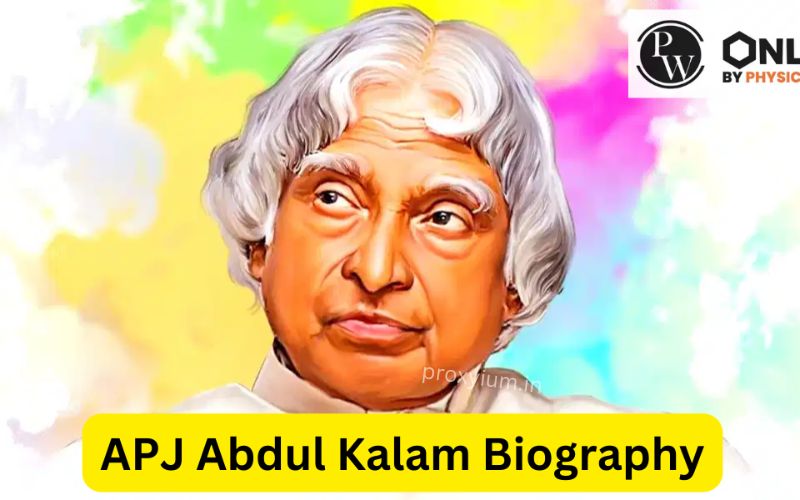APJ Abdul Kalam, also known as the “Missile Man of India,” was a renowned Indian scientist, aerospace engineer, and statesman who served as the 11th President of India from 2002 to 2007. Kalam was a visionary leader who dedicated his life to the advancement of science, technology, and the betterment of India. His inspiring life story and remarkable achievements have made him a beloved figure in the country, and his legacy continues to inspire generations of Indians.
Early Life and Education
Avul Pakir Jainulabdeen Abdul Kalam was born on October 15, 1931, in the town of Rameswaram, Tamil Nadu, India. He was the youngest of five children born to Jainulabdeen, a boat owner, and Ashiamma, a homemaker. Kalam’s early life was marked by poverty, but his family instilled in him the values of hard work, perseverance, and a deep commitment to serving the nation.
After completing his schooling in Rameswaram, Kalam went on to study physics at the Madras Institute of Technology (MIT), where he excelled in his studies and developed a keen interest in aerospace engineering. Upon graduating, Kalam joined the Aeronautical Development Establishment of the Defense Research and Development Organization (DRDO) as a scientist.
Career in the Indian Space Research Organization (ISRO)
Kalam’s early career was marked by his contributions to the Indian space program. In 1969, he joined the Indian Space Research Organization (ISRO) and played a crucial role in the development of India’s first indigenous satellite launch vehicle, the Satellite Launch Vehicle-III (SLV-III). Under his leadership, the SLV-III successfully launched the Rohini satellite into orbit in 1980, a significant milestone in India’s space exploration efforts.
Kalam’s work at ISRO was not limited to satellite development; he also played a pivotal role in the design and development of India’s first indigenous guided missiles, including the Prithvi and Agni missiles. His expertise and vision in the field of aerospace engineering earned him the nickname “Missile Man of India.”
Missile Development and the Pokhran-II Nuclear Tests
In the 1990s, Kalam played a crucial role in the development of India’s missile program, leading the team that conducted the Pokhran-II nuclear tests in 1998. These tests, which demonstrated India’s nuclear weapons capabilities, were a significant milestone in the country’s defense and security strategy.
Kalam’s contributions to the missile development program were not only technical but also strategic. He worked tirelessly to ensure that India’s missile technology was advanced enough to deter potential adversaries and protect the country’s national interests.
Presidency and Contributions as the 11th President of India
In 2002, Kalam was elected as the 11th President of India, a position he held until 2007. During his tenure, he was widely respected for his integrity, humility, and dedication to the nation. Kalam used his position to promote the importance of science, technology, and innovation in India’s development, and he was a vocal advocate for the empowerment of youth and the eradication of poverty.
As President, Kalam continued to inspire and motivate the people of India through his speeches and interactions. He was known for his ability to connect with people from all walks of life, and his message of “Ignited Minds” resonated with millions of Indians.
Literary Works and Inspirational Speeches
In addition to his remarkable achievements in science and technology, Kalam was also a prolific writer and public speaker. He authored several books, including “Wings of Fire,” “Ignited Minds,” and “India 2020,” which have become national bestsellers and are widely read by people of all ages.
Kalam’s speeches were renowned for their ability to inspire and motivate audiences. He often spoke about the importance of education, the power of dreams, and the role of youth in shaping the future of India. His words have touched the lives of countless individuals and have become a source of inspiration for generations of Indians.
Awards and Recognition
Throughout his illustrious career, Kalam received numerous awards and accolades, both in India and internationally. Some of his most notable honors include the Bharat Ratna, India’s highest civilian award, the Padma Vibhushan, the Padma Bhushan, and the Ramanujan Medal.
In addition to these prestigious awards, Kalam was also recognized for his contributions to the field of science and technology. He was awarded honorary doctorates from over 40 universities in India and abroad, and he was a member of several prestigious scientific and engineering academies, including the Indian National Science Academy and the National Academy of Engineering.
Legacy and Impact on Indian Society
Kalam’s legacy as a scientist, statesman, and visionary leader has had a profound impact on Indian society. He is widely regarded as a role model for the youth of the country, inspiring them to pursue their dreams and make a positive contribution to the nation.
Kalam’s commitment to the advancement of science and technology has also had a lasting impact on India’s development. His work in the fields of aerospace engineering, missile development, and nuclear technology has helped to strengthen India’s defense capabilities and position the country as a major player on the global stage.
If you’re interested in learning more about the remarkable life and achievements of APJ Abdul Kalam, you can download his biography in English PDF format by clicking the button below.
Where to Find APJ Abdul Kalam’s Biography in English PDF Format
You can find APJ Abdul Kalam’s biography in English PDF format from a variety of online sources. Some popular options include:
- The official website of the Government of India, which provides a comprehensive biography of Kalam in PDF format.
- Various online book stores and e-book platforms, such as Amazon, Google Books, and Kindle, which offer digital versions of Kalam’s biographies and memoirs.
- Educational and research portals, such as Shodhganga and National Digital Library of India, which host a wide range of scholarly resources, including Kalam’s biographies.
These sources offer detailed and well-researched accounts of Kalam’s life, providing readers with a deeper understanding of his contributions to India and the world.
Conclusion
APJ Abdul Kalam’s life story is a testament to the power of hard work, dedication, and unwavering commitment to a cause. Through his remarkable achievements in science, technology, and public service, Kalam has left an indelible mark on the Indian landscape, inspiring generations of Indians to dream big and work towards the betterment of their country.
By reading Kalam’s biography in English PDF format, you can gain a deeper appreciation for his life and legacy, and be motivated to follow in his footsteps to make a positive impact on the world around you.





